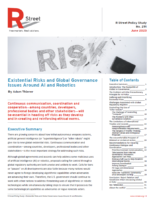There’s been exciting progress in US drone policy in the past few months. First, the FAA in April announced surprising new guidance in its Aeronautics Information Manual, re: drone airspace access. As I noted in an article for the State Aviation Journal, the new Manual notes:
There can be certain local restrictions to airspace. While the FAA is designated by federal law to be the regulator of the NAS [national airspace system], some state and local authorities may also restrict access to local airspace. UAS pilots should be aware of these local rules.
That April update has been followed up by a bigger, drone policy update from FAA. On July 14, the FAA went further than the April guidance and updated and replaced its 2015 guidance to states and localities about drone regulation and airspace policy.
In this July 2023 guidance, I was pleasantly surprised to see the FAA recognize some state and local authority in the “immediate reaches” airspace. Notably, in the new guidance the FAA expressly notes that that state laws that “prohibit [or] restrict . . . operations by UAS in the immediate reaches of property” are an example of laws not subject to conflict preemption.
A handful of legal scholars–like ASU Law Professor Troy Rule and myself–have urged federal officials for years to recognize that states, localities, and landowners have a significant say in what happens in very low-altitude airspace–the “immediate reaches” above land. That’s because the US Supreme Court in US v. Causby recognized that the “immediate reaches” above land is real property owned by the landowner:
[I]t is obvious that, if the landowner is to have full enjoyment of the land, he must have exclusive control of the immediate reaches of the enveloping atmosphere. …As we have said, the flight of airplanes, which skim the surface but do not touch it, is as much an appropriation of the use of the land as a more conventional entry upon it.
Prior to these recent updates, the FAA’s position on which rules apply in very low-altitude airspace–FAA rules or state property rules–was confusing. The agency informally asserts authority to regulate drone operations down to “the grass tips”; however, many landowners don’t want drones to enter the airspace immediately above their land without permission and would sue to protect their property rights. This is not a purely academic concern: the uncertainty about whether and when drones can fly in very low-altitude airspace has created damaging uncertainty for the industry. As the Government Accountability Office told Congress in 2020:
The legal uncertainty surrounding these [low-altitude airspace] issues is presenting challenges to integration of UAS [unmanned aircraft systems] into the national airspace system.
With this July update, the FAA helps clarify matters. To my knowledge, this is the first mention of “immediate reaches,” and implicit reference to Causby, by the FAA. The update helpfully protects, in my view, property rights and federalism. It also represents a win for the drone industry, which finally has some federal clarity on this after a decade of uncertainty about how low they can fly. Drone operators now know they can sometimes be subject to local rules about aerial trespass. States and cities now know that they can create certain, limited prohibitions, which will be helpful to protect sensitive locations like neighborhoods, stadiums, prisons, and state parks and conservation areas.
As an aside: It seems possible one motivation for the FAA adding this language is to foreclose future takings litigation (a la Cedar Point Nursery v. Hassid) against the FAA. With this new guidance, the FAA can now point out in future takings litigation that they do not authorize drone operations in the immediate reaches of airspace; this FAA guidance indicates that operations in the immediate reaches is largely a question of state property and trespass laws.
On the whole, I think this new FAA guidance is strong, especially the first formal FAA recognition of some state authority over the “immediate reaches.” That said, as a USDOT Inspector General report to Congress pointed out last year, the FAA has not been responsive when state officials have questions about creating drone rules to complement federal rules. In 2018, for instance, a lead State “participant [in an FAA drone program] requested a clarification as to whether particular State laws regarding UAS conflicted with Federal regulations. According to FAA, as of February 2022 . . . FAA has not yet provided an opinion in response to that request.”
Four years-plus of silence from the FAA is a long time for a state official to wait, and it’s a lifetime for a drone startup looking for legal clarity. I do worry about agency non-answers on preemption questions from states, and how other provisions in this new guidance will be interpreted. Hopefully this new guidance means FAA employees can be more responsive to inquiries from state officials. With the April and July airspace policy updates, the FAA, state aviation offices, the drone industry, and local officials are in a better position to create commercial drone networks nationwide, while protecting the property and privacy expectations of residents.
Further Reading
See my July report on drones and airspace policy for state officials, including state rankings: “2023 State Drone Commerce Rankings: How prepared is your state for drone commerce?”.



 The Technology Liberation Front is the tech policy blog dedicated to keeping politicians' hands off the 'net and everything else related to technology.
The Technology Liberation Front is the tech policy blog dedicated to keeping politicians' hands off the 'net and everything else related to technology.